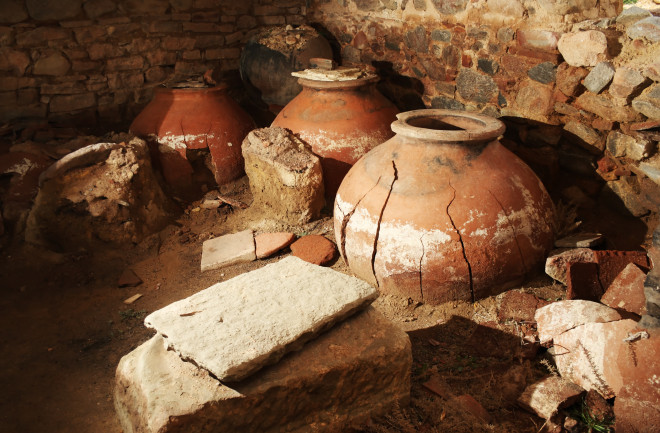You might not think much about the origins of your favorite coffee mug or beaded necklace. Yet, taken together, pottery and beads hold a special place in human history. Researchers have long studied ancient pottery and beads to unearth buried secrets about our collective past.
These items, often found in archaeological sites, can offer a wealth of insights into ancient cultures — for a variety of different reasons.
The Origins of Pottery
Beginning with pottery, this humble craft may have a stake as one of humankind's most significant inventions, as it’s played an important role in societies across the globe for thousands of years. A dizzying array of pottery styles were developed by ancient cultures like those in Greece, Japan, Peru, and more. Varying widely in style and decoration, these ceramics became an integral part of everyday life.
Read More: These Ancient Remains and Relics Reveal Poland’s Bronze Age Rituals
How old, though, is the oldest pottery? Humans developed pottery thousands of years ago; one of the earliest examples is known from Japan, dating back around 15,000 years ago. And around a decade ago, scientists discovered a pottery shard in a cave in China, according to a study in Science, pushing that date back even further to 20,000 years ago.
Researchers long believed that the production of pottery kicked off alongside the development of agriculture, enabling farmers to store different foodstuffs. But, more recently, scientists found that hunter gatherers made their own ceramics, too.
What Role Did Pottery Play in Ancient Life?
Across millennia, ceramics permeated almost every part of life in ancient cultures, including those of ancient Greece and Rome.
Pottery, for example, became essential to daily life and was used for eating, cooking, drinking cups, storage vessels, and more. Ancient Greek ceramics, in particular, are renowned for their intricate and elaborate decorations, and some vessels depict mythological and historical events, and even raucous sex scenes. Such artwork has allowed curious historical insights, like the fact that sandals were used as a “hitting implement” in ancient Athens.
Read More: Stone Tools Question the Evolution of Ancient Human Culture and Technology
For some cultures, pottery was not only important during life, but also in death. Pottery is commonly found in grave sites; in ancient Egypt, for example, burying the dead in clay pots was a common practice. Though it was previously believed this practice was followed by people in poverty out of necessity — by reusing household wares to bury the dead — more recent developments understand the practice as linked to rituals of rebirth.
Pottery Was Important to Ancient Trade Routes
Pottery and ceramics were also essential to ancient trade routes. In the Roman period, pottery vessels crisscrossed the Mediterranean and beyond, bearing many different goods, such as olive oil, wine, and fermented fish.
For example, millions of ancient vessels called amphoras were found in a mountainous pile at Monte Testaccio in Rome. Discoveries at the Egyptian site of Berenike indicate they played a role in Rome’s trade with Indian settlements across the Indian Ocean, as well.
These artifacts were not just an essential part of daily life for ancient peoples; they also act as vital windows into the ancient world for archaeologists and historians. Many items, such as textiles, wood, or other materials may decompose and disintegrate over time, leaving little historical trace, but ever durable, pottery offers glimpses into the past.
Read More: What Evidence Is There For a "Wood Age" to Rival Those of Stone, Bronze, and Iron?
Such discoveries also enable researchers to pry into what the pots contained using residue analysis, enabling scientists to recreate an ancient Egyptian beer recipe, for example, and understand different culinary practices across the Roman empire.
The Origins of Beads
Similarly, beads are often found in archaeological sites across the globe, and the practice of crafting them dates back thousands of years. Making and wearing beads from shells is considered one of the oldest ways of expressing oneself. Scientists debate exactly when the first beads were made, with studies suggesting the first actual examples date back as far as 40,000 years, or even more than 80,000 years ago.
This practice of adorning oneself with beads carried on through time. In the ancient world, they were made from all manner of materials, such as shells, bone, teeth, ivory, glass, precious stones, and even pottery shards. Bead necklaces came in a variety of styles, from simple items with little variation in materials to highly decorative and intricately carved artifacts, requiring both technical and artistic skills.
Archaeologists have even discovered iron beads hammered out from a meteorite in northern Egypt, dating back to 3,200 B.C.E. In this case the beads were strung alongside other materials like gold and carnelian, “revealing the status of meteorite iron as a special material on a par with precious metal and gem stones,” according to the researchers.
What Role Did Beads Play in Ancient Life?
Like pottery, beads held more significance beyond conveying a sense of self, identity, and status. Colorful faience beads, for example, were associated with rebirth in ancient Egypt, while highly prized precious gems like lapis lazuli were worn in life and in death by wealthy individuals of high status.
Red coral, meanwhile, held special significance in many ancient cultures as a ward against the evil eye, and for its supposed healing qualities, leading to a massive trade in this prized material.
In a similar vein, beads and other jewelry made from precious amber were regarded not only as a highly decorative material, but also a protection against illness and evil, particularly for children in ancient Rome.
Read More: This 3,000-Year-Old Sword Was So Well Preserved That It 'Almost Still Shines'

